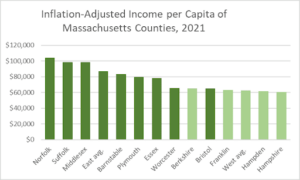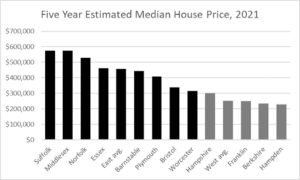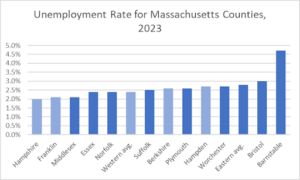A Tale of Two Massachusetts: Wealth and Labor Differences Between East and West
If you ask a Boston-area resident where Western Massachusetts begins, it’s unlikely that they’ll give you a helpful answer. As WBZ news reporter Matt Shearer recently discovered, many simply have little knowledge of, or interest in, anything that lies beyond Worcester. This disregard for the west and its smaller and more disparate communities sees right past the potential and viability of the region. A direct comparison of Western Massachusetts to the rest of the state can illustrate the major differences and potential the region holds.
First, Western Massachusetts is generally considered to include Franklin, Hampden, Hampshire, and Berkshire counties. Eastern Massachusetts includes all counties east of Worcester, or Central Massachusetts. For the purpose of this analysis, Worcester will only be used as a point of reference for comparison. Additionally, the island counties of Dukes and Nantucket will be excluded due to their outlying nature.
Discrepancies in Income

Figure 1: Income per Capita, adjusted for inflation and arranged from highest to lowest. Western counties and averages are in light green. Data is from Pioneer’s MassEconomix website.
East and west differ in several measures of prosperity, including per capita income. As Figure 1 shows, nearly all counties in the east out-earn the west by a considerable margin – the only exception being Bristol, where per capita income is $126 lower than in Berkshire. This notwithstanding, the difference is significant. The east boasts an average per-capita income of $86,794, while the west has a per-capita income of $62,664 – a difference of $24,085, or 28 percent.
This is due in part to a higher cost of living in the Boston area – $3,013 per month, compared to $1,713 in Springfield and $2,209 in Pittsfield, respectively. Excluding large cities, however, shows that the cost of living between eastern and western towns of comparable sizes is roughly equal. Taking this into account, the cost of living difference is considerable. Weymouth and Chicopee, for example, share similar costs of living – $2026 and $2011, respectively. However, the annual per-capita incomes of their counties – Norfolk and Hampden – have a difference of $42,536.
Property Values and Wealth
Property values in the east also tend to exceed that of the west. The median home prices for each county is compared in Figure 2, showing that, across the board, eastern properties are more valuable than their western counterparts.

Figure 2: Median house price, arranged from highest to lowest. Western counties and the average are in gray. Data is from the American Community Survey.
The median home price in the east is $456,725, as opposed to $252,425 in the west – a whopping difference of $204,300, or 81 percent. Even Worcester properties are marginally more valuable than the western average, with a median value of $314,900. This is strong evidence that the typical Western Mass resident both earns less and holds less wealth than the typical Eastern mass resident.
Differences in Employment
While Western Massachusetts counties tend to have lower per capita incomes and median house prices, their labor forces are closer to full employment than those of their eastern counterparts. As depicted in Figure 3, average unemployment in Western Massachusetts is 2.4 percent. Compare this to the average eastern rate of 2.8 percent and Worcester’s rate of 2.7 percent – which is on par with Hampden county – and it becomes clear that fewer Western Massachusetts residents are unemployed.

Figure 3: Unemployment rate, arranged from lowest to highest. Western counties and averages are in light blue. Data is from Pioneer’s LaborAnalytics website.
These differences give insight into the untapped potential of Western Massachusetts. Infrastructure improvements, such as the proposed East-West rail, could reduce the east-west disparities in wealth and income, and also would help connect western industry and available labor in the east.
Peter Mentekidis is a Roger Perry Transparency Intern with the Pioneer Institute. He is a rising senior at Providence College, with a major in Quantitative Economics and a minor in Philosophy. Feel free to contact via email, LinkedIn, or writing a letter to Pioneer’s office.



